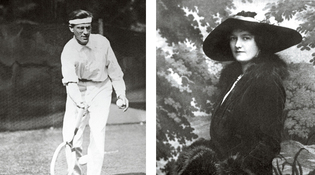 loading
loading
Old YaleWhen the Titanic went downSix Yale men were aboard.  Courtesy Helen Behr SanfordKarl Behr ’06S, one of six Yale men on the Titanic, booked passage on the ship to court Helen Newsom (right), a friend of his sister. When the ship struck the iceberg, Behr went below to awaken Newsom and her parents. They watched in horror from a lifeboat as the ship sank. View full image
April 15 marks the 100th anniversary of the sinking of the Titanic. Of the many moving stories from that iconic event, six belonged to Yale men. Two of them died, one of whom would be remembered by his family for a final act that ensured his son’s survival. Of the four who were rescued, one became famous for an on-board courtship that was one of the few happy endings to emerge from the disaster. Some 1,500 men, women, and children drowned when the luxury cruise ship struck an iceberg off Newfoundland on its maiden voyage; another 705 were rescued. One of the survivors was Yale tennis star Karl Behr ’06S. (The “S” indicates that he went to Yale’s Sheffield Scientific School.) He captured the public’s heart when word of his shipboard romance and subsequent marriage to Helen Newsom led to such headlines as “The First Wedding From the Titanic—How Love Was Born out of the Greatest Shipwreck of Modern Times.” Behr was aboard the Titanic to court Newsom, a friend of his sister’s. According to family lore, Newsom’s mother and stepfather, Sallie and Richard Beckwith ’98, had taken their daughter on a trip to Europe in an attempt to separate the couple. But Behr contrived a business trip to Europe and arranged to book passage on the same ship—the Titanic—for his return to America. (In news accounts, Behr and Sallie Beckwith would deny the story, insisting that the plan had always been for Behr to join the family on the Titanic’s return voyage.) Behr was awake when the boat struck the iceberg. Feeling a jolt, he went up on deck, where passengers were already putting on life belts. The list to starboard was noticeable, so Behr went below to awaken Newsom and the Beckwiths. “All was perfectly calm,” Behr told the Newark Evening Newson April 20. “We waited while the first boat was being filled and lowered. We went in the second boat. At that time, we supposed there were plenty of lifeboats for all the passengers.” He told the Yale Daily News what happened next. The story—which was the first interview with a survivor to be published—took place April 18, on the New York dock where the rescue ship Carpathia brought the survivors.
Behr went on to serve in World War I before becoming a banker. He and Helen were married less than a year after the Titanic tragedy and had four children. Behr’s story stands in stark contrast to the story of fellow alumnus Arthur Ryerson ’71. While on a lengthy European tour, the Ryersons had learned that their older son, a Yale freshman named after his father, had been killed in an automobile accident. Hurrying to get home, the Ryersons booked passage on the first available ship. It was the Titanic. After the ship struck the iceberg, the Ryersons waited for more than two hours to board a lifeboat, recalled their son Jack. (His memories are recounted in A Night to Remember, a best-selling book about the tragedy by Walter Lord ’46LLB, who interviewed some 63 survivors.) As the husbands helped their wives and children board the boat, Arthur Ryerson gave his lifebelt to Victorine, the family’s maid. When an officer tried to keep Jack from joining his mother and sisters in the lifeboat, Arthur shouted, “Of course that boy goes with his mother. He’s only 13.” Ryerson went down with the ship. His son John “Jack” Ryerson became a Yale alum, Class of 1926. The other Yale alumnus to perish on the Titanic was Edward Austin Kent ’75S. Enjoying his retirement after a distinguished career as an architect in Buffalo, New York, Kent had taken a two-month holiday abroad. But he delayed his trip home so he could be on the Titanic’s maiden voyage. Finally, the sixth Yale man was Frederick M. Hoyt ’95S. He was thought at first to have drowned. But after seeing his wife into the last lifeboat, he jumped overboard, swam to her boat, and was pulled aboard. Why do people continue to be fascinated by the Titanic? Walter Lord put it this way: “To social historians it is a microcosm of the early 1900s. To nautical enthusiasts it is the ultimate shipwreck. To students of human nature it is an endlessly fascinating laboratory. For lovers of nostalgia it has the allure of yesterday. For daydreamers it has all those might-have-beens.”
The comment period has expired.
|
|